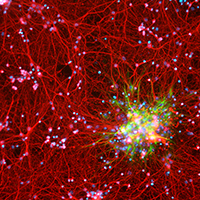Quantitative, structural and molecular changes in neuroglia of aging mammals: A review

Accepted: 27 May 2021
HTML: 11
All claims expressed in this article are solely those of the authors and do not necessarily represent those of their affiliated organizations, or those of the publisher, the editors and the reviewers. Any product that may be evaluated in this article or claim that may be made by its manufacturer is not guaranteed or endorsed by the publisher.
Authors
The neuroglia of the central and peripheral nervous systems undergo numerous changes during normal aging. Astrocytes become hypertrophic and accumulate intermediate filaments. Oligodendrocytes and Schwann cells undergo alterations that are often accompanied by degenerative changes to the myelin sheath. In microglia, proliferation in response to injury, motility of cell processes, ability to migrate to sites of neural injury, and phagocytic and autophagic capabilities are reduced. In sensory ganglia, the number and extent of gaps between perineuronal satellite cells – that leave the surfaces of sensory ganglion neurons directly exposed to basal lamina– increase significantly. The molecular profiles of neuroglia also change in old age, which, in view of the interactions between neurons and neuroglia, have negative consequences for important physiological processes in the nervous system. Since neuroglia actively participate in numerous nervous system processes, it is likely that not only neurons but also neuroglia will prove to be useful targets for interventions to prevent, reverse or slow the behavioral changes and cognitive decline that often accompany senescence.
How to Cite
PAGEPress has chosen to apply the Creative Commons Attribution NonCommercial 4.0 International License (CC BY-NC 4.0) to all manuscripts to be published.
Similar Articles
- Marco Biggiogera, The Feulgen reaction at the electron microscopy level , European Journal of Histochemistry: Vol. 68 No. 1 (2024): 1954-2024: 70 Years of Histochemical Research
- Yao Le, Zhijun Wang, Qian Zhang, Ling Miao, Xiaohong Wang, Guorong Han, Study on the mechanism of Shenling Baizhu powder on the pathogenesis of pregnancy complicated with non-alcoholic fatty liver, based on PI3K/AKT/mTOR signal pathway , European Journal of Histochemistry: Vol. 68 No. 3 (2024)
- A. Kovsca Janjatovic, H. Valpotic, D. Kezic, G. Lacković, G. Gregorovic, S. Sladoljev, G. Mršić, M. Popovic, I. Valpotic, Secretion of immunomodulating neuropeptides (VIP, SP) and nitric oxide synthase in porcine small intestine during postnatal development , European Journal of Histochemistry: Vol. 56 No. 3 (2012)
- Y. Sun, L. Zhu, X. Huang, C. Zhou, X. Zhang, Immunohistochemical localization of nerve fibers in the pseudocapsule of fibroids , European Journal of Histochemistry: Vol. 58 No. 2 (2014)
- Roberto Ghiselli, Guendalina Lucarini, Monica Ortenzi, Eleonora Salvolini, Stefania Saccomanno, Fiorenza Orlando, Mauro Provinciali, Fabio Casciani, Mario Guerrieri, Erratum: Correction of Affiliation , European Journal of Histochemistry: Vol. 64 No. 1 (2020)
- A. Gonelli, D. Milani, E. Rimondi, R. Voltan, V. Grill, C. Celeghini, Activation of PKC-e counteracts maturation and apoptosis of HL-60 myeloid leukemic cells in response to TNF family members , European Journal of Histochemistry: Vol. 53 No. 3 (2009)
- Matias Garrido, Camila Escobar, Constanza Zamora, Carolina Rejas, Juan Varas, Mario Párraga, Sebastián San Martin, Sandra Montedonico, Bile duct ligature in young rats: A revisited animal model for biliary atresia , European Journal of Histochemistry: Vol. 61 No. 3 (2017)
- A Chionna, M Dwikat, E Panzarini, B Tenuzzo, EC Carlà , T Verri, P Pagliara, L Abbro, L Dini, Cell shape and plasma membrane alterations after static magnetic fields exposure , European Journal of Histochemistry: Vol. 47 No. 4 (2003)
- D Fanni, L Pilloni, S Orrù, P Coni, Expression of ATP7B in normal human liver , European Journal of Histochemistry: Vol. 49 No. 4 (2005)
- M Psenicnik, K Jezernik, The role of the Golgi apparatus during terminal differentiation of mouse urothelial surface cells , European Journal of Histochemistry: Vol. 44 No. 4 (2000)
<< < 51 52 53 54 55 56 57 58 59 60 > >>
You may also start an advanced similarity search for this article.

 https://doi.org/10.4081/ejh.2021.3249
https://doi.org/10.4081/ejh.2021.3249










